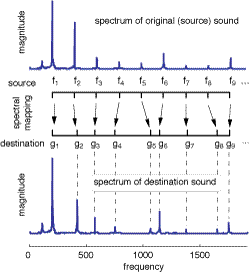|
|
Chapter 9: Beat-Based Signal Processing |
There is an old adage in signal processing: if there is information, use it. The ability to detect beat timepoints is information about the naturally occurring points of division within a musical signal and it makes sense to exploit these points when manipulating the sound. Signal processing techniques can be applied on a beat-by-beat basis or the beat can be used to control the parameters of a continuous process. Applications include beat-synchronized special effects, spectral mappings with harmonic and/or inharmonic destinations, and a variety of sound manipulations that exploit the beat structure. A series of sound examples demonstrate.
| 9.1 Manipulating the Beat 9.2 Beat-Synchronous Filters 9.3 Beat-Based Time Reversal I 9.4 Beat-Based Averaging 9.5 Separating Signal from Noise 9.6 Spectral Mappings 9.6.1 Mapping to a Harmonic Template 9.6.2 Mapping to a n-tet Template 9.6.3 The Make Believe Rag 9.7 Nonlinear Beat-Based Processing 9.7.1 Spectral Band Filter 9.7.2 Spectral Freeze 9.7.3 The Harmonic Sieve 9.7.4 Instantaneous Harmonic Templates 9.8 The Phase Vocoder vs. the Beat-Synchronous FFT 9.8.1 Implementations 9.8.2 Perceptual Comparison |
 |